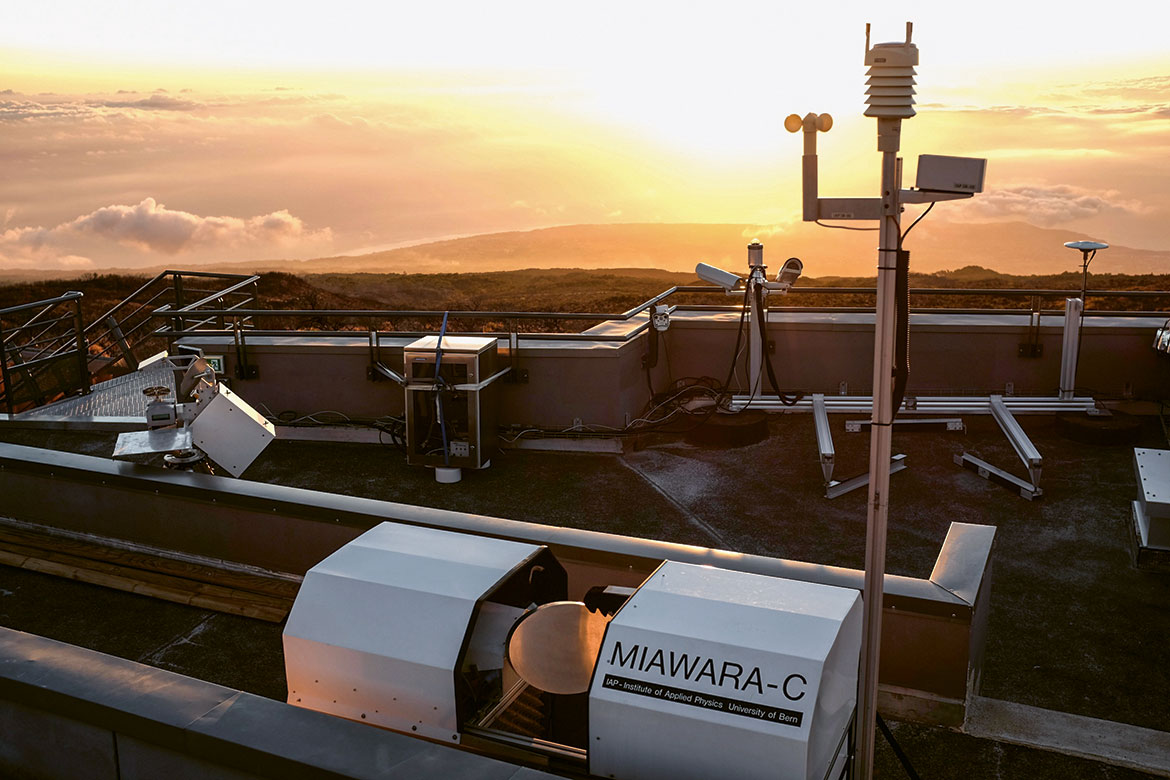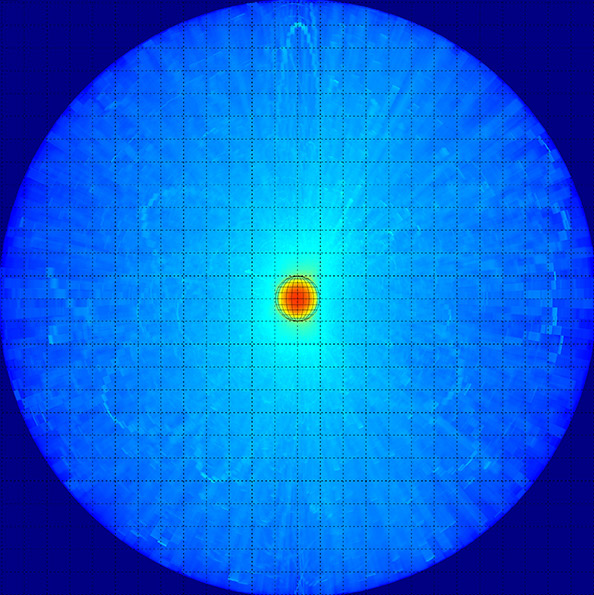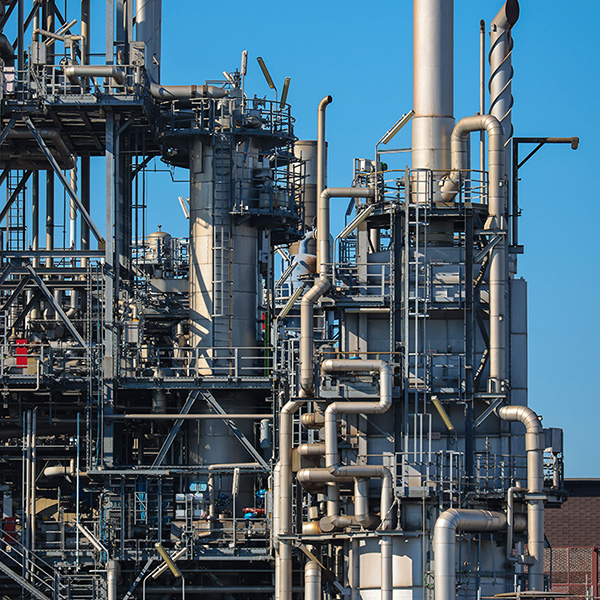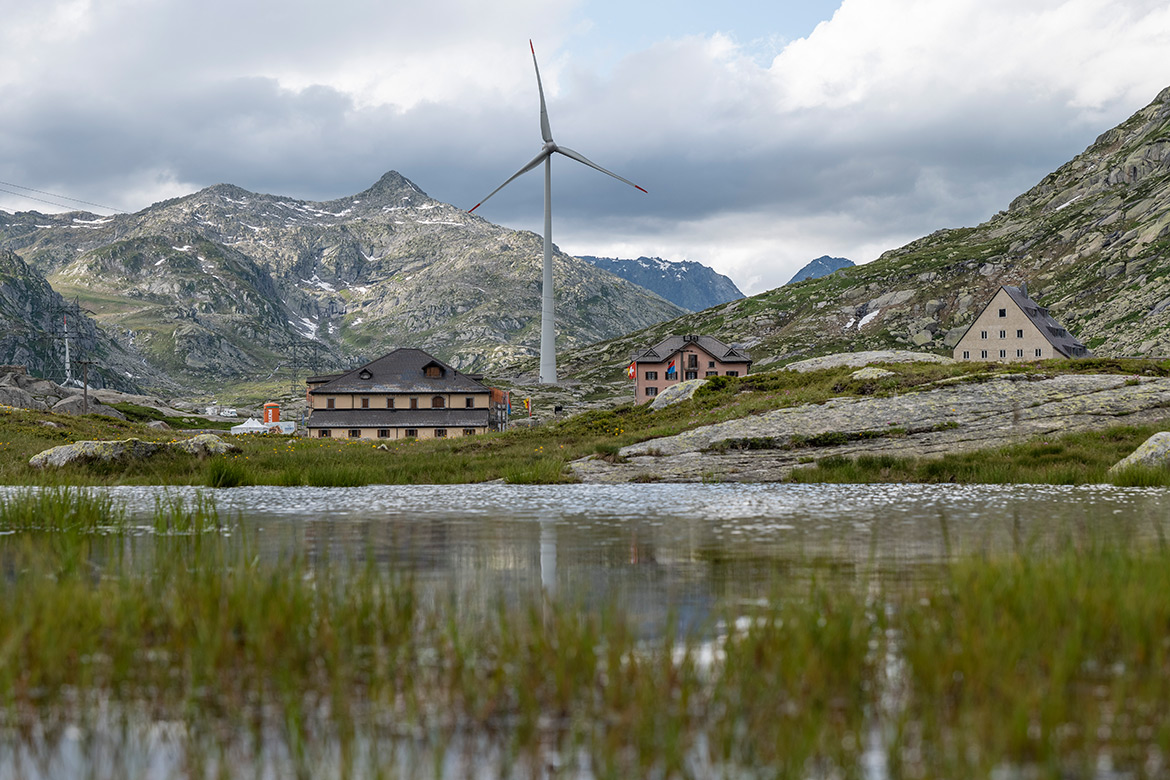Steamy tales
Water vapour is a greenhouse gas, and has a bigger impact on the climate than carbon dioxide. Now researchers are studying its distribution in the different layers of the atmosphere, which allows them to model global warming more precisely.

Humid air above the island of La Réunion. This microwave radiometer belonging to the Institute of Applied Physics of the University of Bern is here measuring the water vapour content of the atmosphere above the Indian Ocean. The same technology is in use in Switzerland. | Picture: Niklaus Kämpfer
When atmosphere researchers from the University of Bern began analysing their data in 2018, they were astonished. For ten years they had been measuring the water vapour in the middle atmosphere above their city. In contrast to the lower layers of the atmosphere, the amount of water vapour had not increased, but had actually sunk by an average of 12 percent. “The reasons for this are not completely clear at the moment”, says Martin Lainer, who today works for MeteoSwiss in Locarno.
Water vapour only makes up four percent of all air molecules at most, but it is the gas that has the biggest effect on the climate (see box below: ‘The most important greenhouse gases’). “Atmospheric water is a significant parameter for the weather and the climate”, says Heini Wernli from the Institute for Atmospheric and Climate Science at ETH Zurich. It occurs throughout the atmosphere and in the lower layers plays a decisive role in the natural greenhouse effect. For a long time, the spatial and temporal distribution of this gas was not understood precisely. Now, new methods and new instruments on the ground and in satellites are enabling researchers to make more precise measurements of the water vapour content of different atmospheric layers.
An atmospheric puzzle
The researchers were surprised by the reduction in water in the mesosphere, some 60 to 75 kilometres above Switzerland. More methane has risen up, mostly from agriculture, and because this gas contains hydrogen atoms, more steam should also have been formed. But the opposite is the case. The researchers believe that air streams in the mesosphere might have changed – both vertically and horizontally. But the precise dynamic and chemical processes involved are puzzling. This makes it all the more vital to carry out measurements in these atmospheric regions too.
The Bernese station has one of just a few microwave radiometers in the world, which enables them to analyse important data about the amount of water vapour in the mesosphere. Their data is then sent to the Network for the Detection of Atmospheric Composition Change (NDACC), a global organisation that was set up in the 1990s because of the hole in the ozone layer, and which is able to recognise cyclical fluctuations and long-term trends over several years. “Our elevation profiles are only regional measurements, but they are representative of Central Europe”, says Klemens Hocke of the University of Bern.
- Water vapour has the biggest impact on the Earth’s greenhouse effect, being responsible for 60 percent of it. But it is not the gas that actually triggers global warming. Higher concentrations of CO2 and concomitant rises in temperature mean that the water content is rising in the troposphere in particular. The result is increased global warming.
- Carbon dioxide is the decisive driver of today’s global warming. Since the start of the Industrial Revolution, the amount of CO2 in the atmosphere has been rising on account of burning fossil fuels, cement manufacture and the deforestation of large woodland areas.
- Methane has a high greenhouse potential per molecule, but is far less common than CO2. There is 2.5 times as much methane in the atmosphere today than there was in pre-industrial times. It comes primarily from agriculture – and it is also leaking from permafrost soil that is thawing on account of global warming.
- Ozone plays an important role in the Earth’s radiation budget in the troposphere. It arises there from carbon monoxide and methane. The ozone concentration in the atmosphere has risen by almost 40 percent since the beginning of the industrial age.
- Industrial gases such as chlorofluorocarbons (CFCs) only exist in small quantities in the atmosphere, but they are very long-lasting, strong greenhouse gases.
There seem to be different developments in every layer of the atmosphere. Whereas the amount of water vapour is sinking in the mesosphere, it is increasing in the two lowest layers, the stratosphere and the troposphere. This trend is confirmed both by the data from the Bern station and also by mobile measurements made throughout Switzerland by the doctoral student Leonie Bernet.
It is the water in the troposphere above all that determines our climate and the weather. Researchers still do not know the exact impact of more water vapour on the speed of change. What is clear is that the increasing man-made emissions of carbon dioxide are causing the present warming of the planet. This greenhouse effect is heightened by feedback with water vapour in the lower atmospheric layers, creating a kind of mantle around the Earth, absorbing its longwave, infrared heat radiation, and thereby warming up the air. The warmer air can in turn absorb more moisture. This is why the concentration of water vapour in the lower atmosphere is increasing by several percent each decade in Switzerland, says Hocke.
A gigantic energy distributor
The researchers don’t just want to investigate individual phenomena in individual atmospheric layers. What they want is to create a global picture of atmospheric circulation. The water vapour content plays a central role in the Earth’s radiation budget, in cloud-forming processes, and thus ultimately in precipitation. At the same time, it is decisive in transporting warmth over great distances. This natural greenhouse gas is a gigantic energy distributor and is vital for atmospheric circulation.
In a joint project between ETH Zurich and the Karlsruhe Institute of Technology (KIT), climate researchers are now trying to combine measurement data acquired from different procedures, in varying resolutions, and from different altitudes, all in order to create a three-dimensional, temporally resolved model of atmospheric processes. Ground stations register data only at their own location. Planes and probes are in a position to track the spatial distribution of water vapour at a very high resolution. Satellites measure a kind of vertical, cumulative concentration of water vapour across the whole globe. The challenge is now to combine all this data.
To this end, the researchers are employing two new techniques. By using antennae on the ground to measure the time delay of microwave signals from navigational satellites, the Global Navigation Satellite System (GNSS) enables the researchers to estimate the total water vapour fields between them. With synthetic-aperture radar signals (SAR), the water disturbs the quality of the images generated, which in turn enables researchers to determine the water’s spatial distribution in the troposphere. “Combining all this data is uncharted territory”, says Harald Kunstmann from KIT. “We can only succeed in this through the interdisciplinary collaboration of physicists, geodesists and climate researchers like we are doing here in Germany and Switzerland. We are here making a fundamental contribution to method development”.
If they succeed in linking all this different data, it will also mean progress for climate and weather modelling. In recent years, these models have already been extended to cover higher altitudes. They only used to extend to 30 kilometres, but they now go as far as some 70 kilometres. But modelling the atmospheric water cycle overall remains a challenge, as Wernli can confirm.
Together with Matthias Schneider in Karlsruhe, Wernli is pursuing a new approach by investigating atmospheric circulation using water molecules of different weights (isotopologues). According to theoretical studies, their distribution can provide important information about the atmospheric water cycle.
The results of these research projects are providing new opportunities for us to achieve a better understanding of the global circulation of this important greenhouse gas and its role in the weather and the climate. “As a result of climate change, the warmer atmosphere will be able to absorb more and more water vapour, and the whole water cycle will change because of this”, says Kunstmann. “If we are going to make better predictions, we will in future need more data on water vapour and expanded models”.




